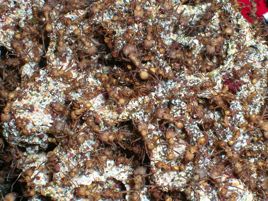
Buns are flying across the airwaves of The Last Word on Nothing: currant buns, sticky buns, cinnamon buns, steamed buns, hot dog buns–all kinds of buns, but thankfully no buns of steel (yet). The bunfight began several weeks ago with an exchange between myself and my esteemed colleague, Ann Finkbeiner, on the benefits and burdens of bugs. Now I have discovered two fascinating ant stories to add to my armamentarium.
The ants in question don’t eat sticky buns, though some species, like the odorous house ant, are very fond of sugary sweets. No, the first type of ant is a leaf-cutting fungus farmer living in Trinidad and Tobago. Acromyrmex octospinosus grows and feeds on a fungus called Leucoagaricus gongylophorus, “which it cultivates on a medium of masticated leaf tissue” (thanks, Wikipedia).
Scientists led by Matt Hutchings and his Ph.D. student Joerg Barke of the University of East Anglia in the U.K. have discovered that these ants use multiple antibiotics as weed killers to maintain their fungus gardens.

The antibiotics are produced by bacteria that are both transmitted by the queen of the colony and gathered by the worker ants from their environment. The ants apply them to the “weeds” or unwanted fungi in their gardens, in the same way that doctors use multi-drug therapy to treat infections in humans. In fact, the researchers have isolated a new antibiotic from one of these bacterial species that’s related to a clinically important antifungal called nystatin, which is used to treat fungal infections of the skin, mouth, vagina, and intestinal tract. “We’re excited about the potential of these ants and other insects to provide us with new antibiotics for medical use,” Hutchings says.
In other important ant news, biologists at the University of Florida have discovered that ants defend trees on the African savanna from the ravages of elephants. Columns of ants will crawl up into elephant trunks to stop the lumbering beasts from devouring the trees. “Swarming groups of ants that weigh about 5 milligrams each can and do protect trees from animals that are about a billion times more massive,” reports researcher Todd Palmer. He and his former post-doc student Jacob Goheen noticed that elephants rarely ate a widespread Kenyan tree species called Acacia drepanolobium, which is guarded by ants that derive shelter and sugary nectar in return. But they would feed on other trees that did not harbor these ants.
When elephants at a wildlife orphanage were offered a choice between “ant plant” trees with and without ants on the branches, they readily ate the ant-less trees. Elephants also attacked trees on the savanna from which the researchers had removed the ants. In fact, the ants may play a critical role in sequestering greenhouse gases, since unharmed trees absorb carbon dioxide from the atmosphere. Ant plants “are distributed throughout east Africa from southern Sudan all the way over to eastern Zaire and down through the horn of Africa and Tanzania,” Palmer says. So ants have “a major impact on the ecosystems in which they live.”
Bun image courtesy of Andreas Ivarsson